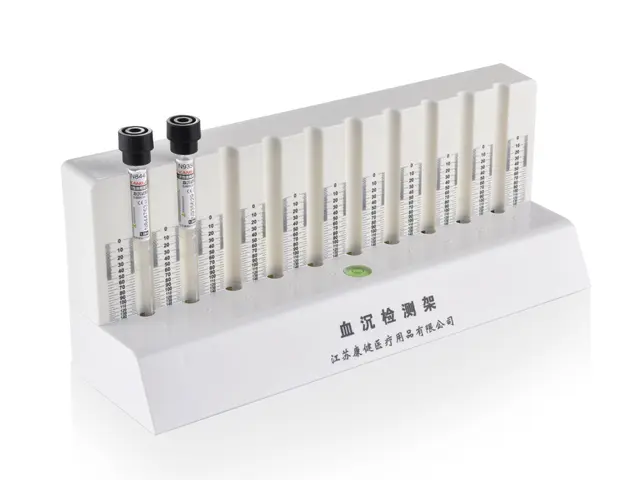Modern ESR Detectors: Transforming Inflammatory Diagnostics and Enhancing Patient Care
In the complex and ever-evolving landscape of modern healthcare, diagnostic tools play a crucial role in patient management. Among these tools, the ESR detector (Erythrocyte Sedimentation Rate detector) has emerged as an indispensable instrument in the assessment and monitoring of inflammatory conditions. By measuring the rate at which red blood cells settle in a tube over a specified period, the ESR detector provides valuable insights into systemic inflammation, aiding clinicians in diagnosing a wide range of medical conditions. This article Kangjian explores the operational advantages of ESR detectors in the medical industry, emphasizing their role in improving diagnostic precision and patient outcomes.
What is the ESR Detector?

An ESR detector is a laboratory instrument designed to measure the erythrocyte sedimentation rate (ESR), a common hematology test used to assess the presence of inflammation, infection, or other medical conditions. The ESR measures the rate at which red blood cells (erythrocytes) settle at the bottom of a vertical tube of anticoagulated blood over a specified time, typically one hour in traditional methods. Modern ESR detectors automate and accelerate this process, providing faster, more accurate, and standardized results. These advanced devices often rely on optical sensors, algorithms, and real-time analysis to monitor the sedimentation process, eliminating the need for prolonged manual observation.
Operational Advantages of Modern ESR Detectors
Automation and Standardization
Modern ESR detectors are revolutionizing the traditional approach to erythrocyte sedimentation rate (ESR) testing through automation. Unlike manual methods, which are inherently prone to inter-operator variability and environmental influences, these advanced devices rely on sophisticated algorithms and digital imaging techniques to calculate sedimentation rates. Automation minimizes human intervention, thereby reducing errors associated with manual pipetting, timing inconsistencies, and subjective result interpretations. Additionally, automated systems ensure uniform procedures across tests, promoting reproducibility and compliance with clinical guidelines. By standardizing ESR testing, these devices provide reliable, comparable results, fostering greater confidence among clinicians in diagnostic and monitoring processes.
Rapid Turnaround Time
One of the most significant operational advantages of modern ESR detectors is their ability to deliver results in a fraction of the time required by traditional methods. Conventional ESR tests typically necessitate a waiting period of at least 60 minutes for sedimentation to occur naturally, which can delay clinical decision-making in critical situations. In contrast, modern devices use innovative technologies, such as infrared optics or real-time sedimentation tracking, to produce accurate results within 20–30 minutes. This rapid turnaround time is particularly beneficial in emergency settings or high-throughput laboratories, where timely results are essential for patient management. It not only enhances laboratory efficiency but also accelerates the diagnosis and treatment process, ultimately improving patient outcomes.
Small Sample Requirements
Another standout feature of modern ESR detectors is their ability to perform tests with minimal blood volume requirements. Traditional ESR tests often require up to 2 mL of blood, which can be a challenge for vulnerable patient groups, such as neonates, children, or the elderly, who may have limited blood volume or difficulty with venipuncture. Modern detectors address this issue by requiring as little as 100–200 microliters of blood, collected from capillary or venous sources. This capability not only makes the testing process more patient-friendly but also expands the applicability of ESR testing in specialized scenarios, such as neonatal intensive care units (NICUs) or outpatient clinics, where smaller sample volumes are the norm.
Integration with Laboratory Systems
Efficiency in modern laboratories depends heavily on seamless data management, and modern ESR detectors excel in this area. Many of these devices are designed to integrate directly with Laboratory Information Systems (LIS) and hospital networks. Through connectivity features like HL7 interfaces, these detectors can automatically transmit results, eliminating the need for manual data entry and reducing transcription errors. This integration also enables real-time tracking of test status, centralized result storage, and streamlined reporting. Furthermore, laboratory staff can monitor instrument performance remotely and manage workflows more effectively. By supporting interoperability, modern ESR detectors contribute to a cohesive laboratory ecosystem, enhancing overall operational efficiency.
Built-In Quality Control
To ensure consistent and reliable performance, modern ESR detectors come equipped with robust quality control mechanisms. These features include automated calibration, internal reference checks, and anomaly detection algorithms that flag potential issues, such as abnormal sample conditions or instrument drift. Some systems also provide real-time alerts for maintenance needs or compliance with accreditation standards, ensuring uninterrupted operation. Built-in quality control not only boosts the accuracy and reliability of test results but also helps laboratories maintain regulatory compliance effortlessly. This proactive approach to quality management reduces the risk of errors, builds trust in the results, and supports laboratories in delivering the highest standards of patient care.
The ESR detector has become an indispensable tool in modern medicine, bridging the gap between non-specific inflammation markers and actionable clinical insights. Its ability to quickly, accurately, and efficiently assess inflammatory activity enhances diagnostic workflows, supports tailored treatment plans, and ultimately improves patient outcomes. From routine screenings to specialized applications in pediatrics, oncology, and geriatrics, the ESR detector's role in healthcare is unparalleled. As technology continues to advance, this powerful diagnostic tool will remain at the forefront of patient care, helping clinicians make informed decisions and deliver optimal outcomes.
https://www.kangene.com/Vacuum-Blood-Collection-Tube/ESR-Fast-Detector.html
www.kangene.com
Jiangsu Kangjian Medical Supplies Co., Ltd.